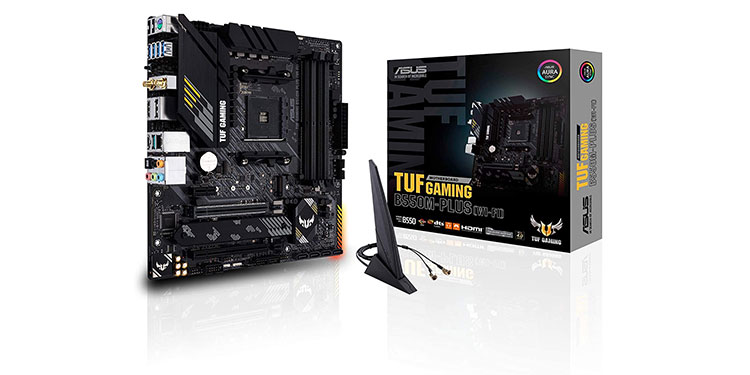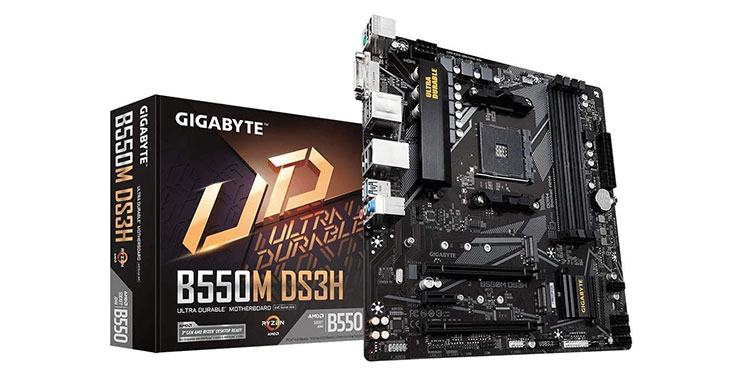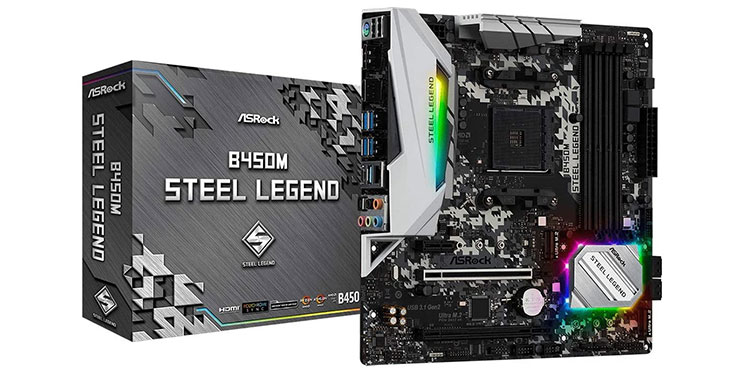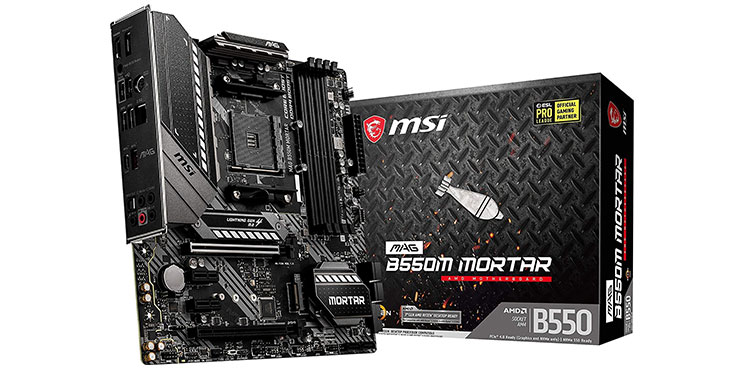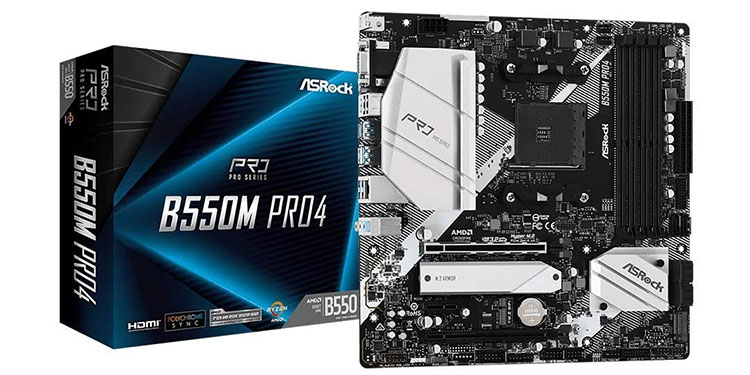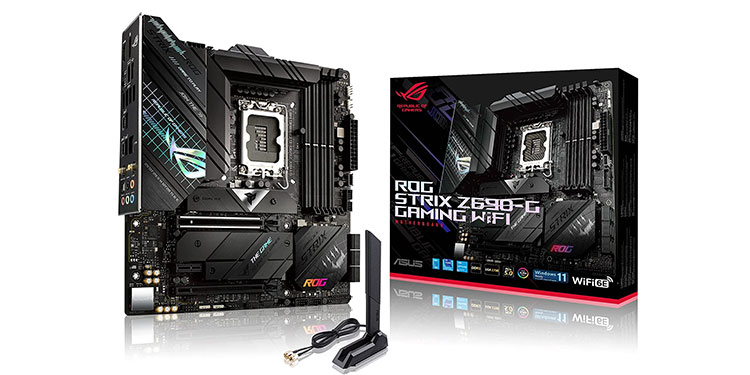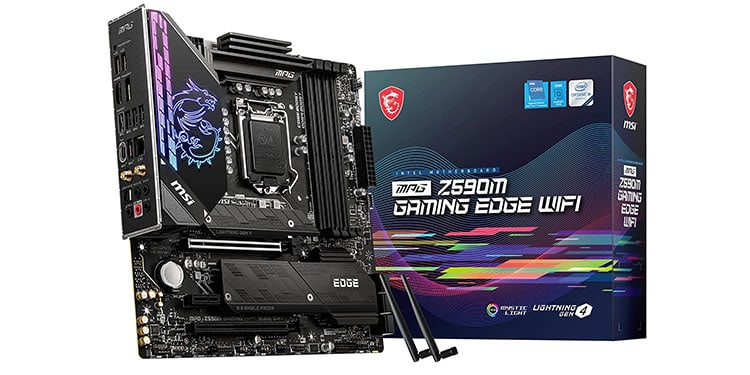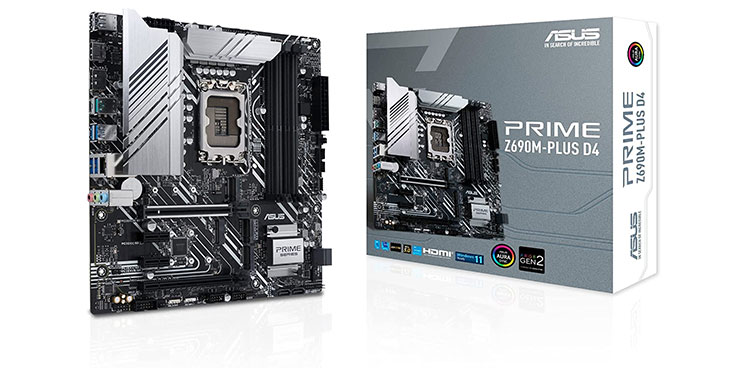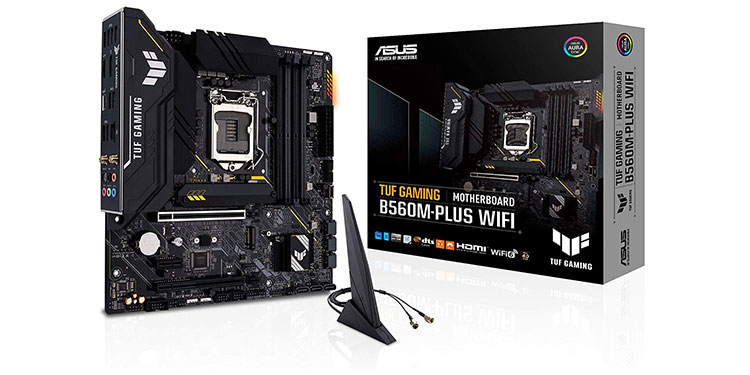Micro ATX, shortened to mATX, was designed for this exact purpose. With a slight premium, these boards perform shoulder-to-shoulder with standard ATX motherboards and even surpass them in certain regards. It doesn’t matter if you’re looking for a budget ready-to-use mATX motherboard or a premium high-end one, I’ve got something for you on this list.
Best mATX Motherboards Overview
Explaining Micro ATX and what makes it different
If you aren’t sure what Micro ATX is, don’t worry- I’m here to help.To understand Micro ATX, you’ll first want to understand ATX, which it is based on.ATX is the standard motherboard form factor. The most important difference between ATX and Micro ATX is size, but you’ll also see some other differences, too, especially in terms of expansion.Essentially, Micro ATX offers less storage and graphics expansion options. However, if you aren’t running extensive RAID setups or multi-GPU configurations, you’re unlikely to actually encounter an issue here.
Small Package, Big Value: Top 5 Features to Prioritize
Although most mATX motherboards available today are sufficient for general use cases and gaming, if you want the highest amount of value, there are some features you need to look out for. Motherboard manufacturers often either subtract or downgrade these features sneakily to make up for the smaller form factor. However, if you’re mindful of these, you can end up buying a motherboard that fits your requirements perfectly. You might already be knowledgeable about general motherboard buying tips, but these are the features that you need to specifically pay attention to when buying an mATX motherboard. So, let’s discuss them in-depth:
Sufficient RAM Capacity
When looking for an mATX board, you’ll notice that some of them only feature two DIMM slots while the mid to high-end ones offer four slots. How many you really need, of course, depends on your use case. Typically, in 2022, two DIMM slots probably won’t cut it for most users, both for current use and future upgrades.So, it’s important to buy a motherboard with four DIMM slots. Whether it’s DDR5 compatible or has a high frequency are more user-specific factors that you can decide for yourself.Of course, buying a motherboard with four DIMM slots doesn’t mean you need to populate them all at once; you can just use two in dual-channel mode initially and then upgrade later on as you see fit. Overall, it’s better to have two sitting empty rather than not having them in the first place and needing to buy a new motherboard altogether.
Build Quality
Durability is an important factor for long-term use in any motherboard. However, it becomes even more important with mATX since you’re going to be working in a cramped case with many components close together, so the chances of damage and scratching increase.Moreover, many SFF builds are often taken away from the safety of the desk and used as portable, ready-to-go PCs at LAN parties and gaming conventions where they are likely to be mishandled. So, durability becomes a priority. Thus, it’s important to go for a motherboard that has a tough PCB, aluminum heatsinks, and M.2 covers.
SATA Connectors
It’s common knowledge that a good SSD won’t give you an FPS boost, but it will definitely make your overall experience much smoother by lowering loading time and asset pop-ins. Many gamers have noted that a leap from a low-RPM HDD to an SSD is a next-level improvement.This is why SATA ports are very important: almost every internal storage drive needs one. Especially SATA 3, which is much faster than SATA 2. Most mATX motherboards have at least four of them, which is sufficient for the everyday user.However, it’s always good to check nevertheless. So, with that in mind, make sure to go for a motherboard that has enough of them, for current use and future upgrades.
Heavy-Duty VRMs and Heatsinks
If you’re planning on using your mATX motherboard for overclocking, this information could come in handy. For the uninitiated, VRMs are responsible for giving stable and clean voltage to the CPU as needed, much like a fuel injection system in a car engine.So, the more VRMs you have in your motherboard, the more stable your system should be. Along the same lines, VRM heatsinks help to dissipate all that heat and create a proper condition for good overclocks and stable operations.Both of these also contribute to a longer lifespan for the motherboard: more power phases equal less load on the transistors, and heavy-duty heatsinks save the PCB from overheating and degrading over the long term.Although having premium features like an onboard chipset fan and a temperature readout panel can be awesome, they’re only seen in high-end ATX motherboards and aren’t necessary for most users. In reality, just having sufficient VRMs and heatsinks is more than enough.
Ample I/O
We all love our wealth of peripherals: our keyboards, mice, headphones, macro keypads, and Streamdecks. So, it’s unfortunate when the motherboard doesn’t offer adequate internal and external ports to be able to power and connect with them all. Not only that, a ton of time can be lost when it doesn’t have USB-C for quick transfer.So, it’s good to go for an mATX motherboard that serves all those needs and doesn’t limit you in any way. This will also save you from cable management headaches in the future by not needing to buy expansion ports.Even though a motherboard doesn’t contribute directly to the performance of the PC, since it serves as the primary hub for all the components it’s essential to have the specs and features you need. Not only for today, but also for tomorrow. So, now that you know what you need to look out for in your mATX motherboard, let’s go through our best picks list…
ASUS TUF Gaming B550M Plus(WiFi) – Best AMD mATX Motherboard
Most SFF builders use AMD because generally, Ryzen CPUs are much more energy efficient compared to their Intel counterparts. This is because power efficiency equals less heat, and less heat means that a smaller cooler could suffice without performance suffering. These are big Plus signs for anyone trying to build a PC in a cramped and limited case.
CPU Socket: AM4 RAM Capacity: 128GB DDR4 (4 Slots up to 4866MHz) Networking and Connectivity: Intel WiFi 6 and 2.5G LAN with Asus LANGuard Form Factor: mATX (9.6 x 9.6 inches) RGB Support: Yes (ASUS Aura Sync) Audio: Realtek ALC S1200A
With that in mind, one of the best mATX motherboards you can buy for your Ryzen CPU is the ASUS TUF Gaming B550M Plus. It has an 8+2 power delivery system, making for a total of 10 phases, along with strong aluminum VRM and chipset heatsinks.When it comes to staying connected online, this motherboard has the features you’d need. It comes integrated with WiFi 6 out-of-the-box, so no need to mess around with pesky PCIe WiFi expansion cards anymore.Plus, you also get a 2.5 LAN port with ASUS LANGuard. This is not only useful for web browsing and downloading but also for competitive FPS games where a single millisecond can make the difference between winning and losing.The RGB lighting, limited to the one series of LEDs in the lower right corner of the board, is minimal but tasteful. Moreover, the matte black accent also makes this board suitable for an all-black stealthy build. Overall, the ASUS TUF Gaming B550M Plus is a fantastic motherboard for any Ryzen SFF build.
Gigabyte B550M DS3H – Best Value-Packed AMD mATX Motherboard
If you like the TUF Gaming B550M Plus, but are looking for a more budget-friendly and value-packed option, the Gigabyte B550M BS3H could be it. The compromises made to hit the $100 price point aren’t deal breakers for most users, and it has all the bells and whistles you’d need for a beast SFF build.
CPU Socket: AM4 RAM Capacity: 128GB DDR4 (4 Slots up to 4733MHz) Networking and Connectivity: 1G Ethernet Port Form Factor: mATX (9.6 x 9.6 inches) RGB Support: No (RGB Fusion 2.0) Audio: Realtek 7.1 Audio Codec
The 5+3 power phase design is sufficient for powering mid-range CPUs like the 5600x with some room for overclocking too. The heatsinks on this motherboard are fairly basic, but should be good enough for general everyday use. So, if you get this board, make sure to use a PC case with plenty of positive airflow to avoid any issues.Other than that, it’s a pretty decent board overall: you get a PCIe 4.0 Ready x16 slot, dual NVMe M.2 slots, six total USB 3.2 ports, 1G Ethernet, and many other useful features.All in all, if you can overlook the mediocre cooling capacity, no RGB lighting, and lack of WiFi connectivity, and just want a good mATX B550 chipset motherboard that works, the Gigabyte B550M BS3H should be a good pick!
ASRock B450M Steel Legend – Best for Full White PC Build
SFF PC builds are always unique and attractive, however, white and silver ones stand out even more. If you’re building a PC along those lines with a Ryzen CPU, I highly recommend you choose the ASRock B450M Steel Legend as your motherboard. Here’s why.
CPU Socket: AM4 RAM Capacity: 128GB DDR4 (4 Slots up to 3533MHz) Networking and Connectivity: 1G Ethernet Port Form Factor: mATX (9.6 x 9.6 inches) RGB Support: Yes (ASRock Polychrome) Audio: Realtek ALC892
The 6 phase power design, while not impressive, should be good enough for mid-range Ryzen CPUs like the 5600x. The heatsink design is also decent, but be wary of overclocking on this motherboard if possible.Being an ASRock product, it also comes with its suite of software applications like Polychrome and the App Shop. If you own other ASRock components in your setup too, this motherboard could be a valuable addition.The build quality hasn’t been neglected here either. The high-density glass fabric PCB with a 2oz copper plate is tough and durable. In terms of electric durability, it also offers full spike protection for all USB ports, along with the audio and ethernet port.While every other motherboard on this list offers up to 128GB of RAM capacity, the ASRock B450M Steel Legend is stuck at 64GB with speeds limited up to 3200MHz. If you’re not a content creator or developer and don’t need that level of RAM, more power to you. However, if you’re a professional then this can be a huge limiting factor.When it comes to design, the sapphire black PCB with a white design makes this motherboard a perfect pick for a white-themed PC.Overall, if you’re looking from a purely value-based viewpoint, other motherboards like the MSI MAG B550M Mortar and the Gigabyte B550M DS3H are better picks. If you’re in the market for an affordable mATX B550 chipset motherboard specifically in white, then the ASRock B450M Steel Legend is the way to go.
MSI MAG B550M Mortar – Best for Stealth Build
Ask any enthusiast SFF PC builder, and they’ll tell you that one of the biggest challenges of builds like this is cooling; moreover, trying to overclock without damaging components permanently. This is not only because of the smaller space, but also the technical limitations that come with that. Heatsinks naturally need to be big in order to dissipate heat efficiently.
CPU Socket: AM4 RAM Capacity: 128GB DDR4 (4 Slots up to 4400MHz) Networking and Connectivity: 2.5G Ethernet Port with LAN Manager Form Factor: mATX (9.6 x 9.6 inches) RGB Support: No (MSI Mystic Light) Audio: Realtek ALC1200 7.1
If you’ve seen the MSI MAG B550 Tomahawk before, you’ll notice that the Mortar is like its younger brother. Other than the shorter form factor, the main difference is in the power phases. The Tomahawk has a 10+2+1 design while the Mortar has 8+2+1, making for a total of 11 phases. For an mATX motherboard, this is impressive.Let’s talk about cooling now. It has an extended heatsink, thermal pads, and the PCB comes with 2oz thickened copper too. Plus, the pre-installed I/O shield contributes to durability as well.In terms of design, it stays pretty minimal. The lack of RGB might be a Plus for you if you’re looking to build a stealthy and no-RGB PC and aren’t interested in bright and stand-out designs.Overall, if you’re looking for a solid mATX motherboard for your Ryzen CPU and plan on doing some overclocking, the MSI MAG B550M Mortar could be the right pick without burning a hole in your pocket. It has great VRMs and cooling capacity along with durable build quality. So, you really can’t go wrong with this motherboard!
ASRock B550M Pro4 – Best for Monochrome/Silver Build
In contrast to the ASRock B450M Steel Legend, if you’d like a more comforting silver tone to your PC that is easy on the eyes but also provides adequate features, I highly recommend you go with the ASRock B550M Pro4 as your motherboard. Not only for its design, but also for the VRM, build quality, and I/O.
CPU Socket: AM4 RAM Capacity: 128GB DDR4 (4 Slots up to 4733MHz) Networking and Connectivity: 1G Ethernet Port Form Factor: mATX (9.6 x 9.6 inches) RGB Support: No (ASRock Polychrome) Audio: Realtek ALC1200
It has an eight-phase power design, which isn’t as impressive as some of the other options on this list, but still pretty good. If you need quick transfer speeds for your projects, the one USB-C 10G ports along with the Hyper M.2 PCIe Gen4x4 slot will come in handy.Durability plays a part too, and the high-density glass fabric PCB of the ASRock B550M Pro4 will guarantee long-term use. Plus, the full M.2 heatsink and full spike protection will help out as well.In terms of design, the sapphire black PCB with silver accents on top, especially the heatsink and the M.2 covers, makes this motherboard a good fit for any silver PC build. Everything considered, the ASRock B550M Pro4 is a great option for you’re looking for a silver mATX motherboard for your Ryzen build!
ASUS ROG Strix Z690-G – Best Intel mATX Motherboard
Let’s move over to Intel motherboards now. With the new 12th Gen Alder Lake CPUs along with DDR5 compatibility, Z690 motherboards are the most advanced and cutting-edge motherboards out there.
CPU Socket: LGA 1700 RAM Capacity: 128GB DDR5 (4 Slots up to 6000MHz) Networking and Connectivity: Intel WiFi 6E, Bluetooth 5.2, and 2.5G Ethernet Port with ASUS LANGuard Form Factor: mATX (9.6 x 9.6 inches) RGB Support: Yes (ASUS Aura Sync) Audio: SupremeFX 7.1 ALC4080
As you may know, ASUS mainly focuses on high-end and valuable components in their lineup. The ROG Strix Z690-G is no different in that regard. At almost $350, it’s definitely a premium product, but it offers features to equal that price as well.It has a 14+1 power stage design with a ProCool II power connector, along with high-end alloy chokes and capacitors. To dissipate all the heat generated, it has a VRM heatsink, a fan-less PCH heatsink, double-sided M.2 heatsink, and hybrid fan headers. To control all your case fans intuitively, it also has the Fan Xpert 4 utility.In terms of I/O, it supports HDMI 2.0 and DisplayPort 1.4 output; triple M.2 slots; USB 3.2 Gen 2×2 Type-C; and front-panel USB 3.2 Gen 2×2 Type-C connectors. So, you need to worry if you have a ton of peripherals and also need fast storage transfer speeds.The ROG Strix Z690-G is also built to last. A tough PCB and plenty of aluminum make it hard to damage. Even the RAM sticks have been kept in mind: it has SafeDIMM, which is a metal divider for increased support and protection.Overall, the ROG Strix Z690-G is a fantastic motherboard. If you’re looking for a great Z690 chipset but want it in a smaller form factor without sacrificing on features, definitely keep this one in mind!
MSI MPG Z590M Gaming Edge WiFi – Best MSI mATX Motherboard
Although the Z690 chipset is getting all the attention right now, if you’re using a 10th or 11th Gen CPU then a good Z590 motherboard will be more than sufficient for you. Since they’re an older generation, they’re priced relatively low but still provide solid feature sets when it comes to VRMs, storage transfer, and thermals.
CPU Socket: LGA 1200 RAM Capacity: 128GB DDR4 (4 Slots up to 5333MHz) Networking and Connectivity: Intel WiFi 6E and 2.5G Ethernet Port Form Factor: mATX (9.6 x 9.6 inches) RGB Support: Yes (MSI Mystic Light) Audio: Realtek ALC4080
Of course, there are many Z590 motherboards out there, but the best mATX one is the MSI MPG Z590M Gaming Edge WiFi. It has a mighty 12+1+1 duet rail power system and 8+4 pin CPU power connectors for stable and clean usage.To keep things from getting overheated, it has an enlarged heatsink with an in-build heat pipe. Additionally, there are also thermal pads and aluminum Frozr Shields for the M.2 drives. This will all ensure that the motherboard stays cool even in extreme scenarios and works smoothly.All in all, the MSI MPG Z590M Gaming Edge WiFi is a great mATX Z590 motherboard. If you’re looking for a high-end solution for your 10th or 11th Gen Intel-based SFF build then this one should definitely be taken as a serious option.
ASUS Prime Z690M Plus – Best ASUS mATX Motherboard
As you’ve probably noticed by now, Z690 motherboards tend to be pretty expensive. However, that doesn’t need to be the case, and the ASUS Prime Z690M Plus makes that point. For around $200, it offers the LGA 1700 socket to power your 12th Gen Alder Lake CPU and many other benefits on top as well.
CPU Socket: LGA 1700 RAM Capacity: 128GB DDR4 (4 Slots up to 5333MHz) Networking and Connectivity: 1G Ethernet Port Form Factor: mATX (9.6 x 9.6 inches) RGB Support: No (ASUS Aura Sync) Audio: Realtek 7.1 Codec
When it comes to power, it has a 10+1 DrMOS design along with alloy chokes and durable capacitors for stable and clean power delivery. For cooling, it has an impressive combination of VRM, PCH, and M.2 heatsinks. If you’re going to be using a ton of fans then you’ll be grateful for the hybrid fan headers and Fan Xpert 4 utility included with the board.As with most Z690 motherboards, it includes PCIe 5.0, an Intel 1G Ethernet port, two USB Type-C ports, and also Thunderbolt 4 header support. So, you’ll get fast transfer speeds among your SSDs and also ports for all your peripherals.If you’re looking for an affordable entry-level Z690 motherboard, the ASUS Prime Z690M Plus could be a good option. While it doesn’t look as good as some of its competitors from other brands, it still gets the job done. Think of it like purchasing the base model of a car: you get all that you really need and don’t need to pay for any features you won’t fully utilize anyway.
ASUS TUF Gaming B560M Plus WiFi – Best Budget-Friendly Intel mATX Motherboard
Intel motherboards usually tend to be more expensive than their AMD counterparts, especially if you’re looking at the higher-end ones. However, the ASUS TUF Gaming B560M Plus WiFi stands out since it provides an awesome amount of value for the price.
CPU Socket: LGA 1200 RAM Capacity: 128GB DDR4 (4 Slots up to 5000MHz) Networking and Connectivity: Intel WiFi 6, Bluetooth 5.0, and 2.5G Ethernet Port with ASUS LANGuard Form Factor: mATX (9.6 x 9.6 inches) RGB Support: Yes (ASUS Aura Sync) Audio: Realtek ALC897
First of all, it has 8+1 power stages, a 6-layer PCB, and durable capacitors for more stable and reliable power delivery. These stats might not sound very interesting, but remember, this motherboard only works with 10th and 11th Gen CPUs. If you’re working with a 12th Gen one then you’d rather go with Z690 with better VRMs anyway.Another point: this motherboard also allows you to overclock your memory with non-K CPUs, for example, the i5-11400. As listed in the specs sheet, it can go up to 5000MHz, which is quick and could bring a noticeable improvement to your average FPS in games.Overall, with nine rear USB ports, in-built WiFi 6, two display-outs, and multiple RGB and fan headers, it’s just a mind-blowing amount of value packed into a 9.6 x 9.6-inch package. Not only that, but it also has many beginner-friendly features like tool-less M.2 latches and a pre-installed I/O shield.So, keep an eye on this one if you’re looking for a value-packed option for your 10th or 11th Gen Intel CPU.
Are Micro ATX Motherboards Capable of CPU Overclocking?
Many beginner PC builders often assume that due to the smaller form factor of Micro ATX motherboards, they are incapable of CPU overclocking. That might be true in some cases. However, if you pick out one with good VRMs and heavy-duty heatsinks, overclocking should be a breeze.As I’ve explained before, they’re essential not only for effective overclocking but also for stable long-term usage. Keeping these factors in mind, the motherboards from the above list that are suitable for CPU overclocking are the TUF Gaming B550M Plus, the MSI MAG B550M Mortar, and the ASUS ROG Strix Z690-G.If you go for one of these or one that is compliant with the above-mentioned tips, then it most likely won’t be a bottleneck when overclocking. Of course, you would also need to have a powerful enough CPU cooler and a PC case with positive airflow. But, other than that, you should be good to go!
Can I use a Micro ATX motherboard in an ATX case?
Yes, absolutely. This is actually a fairly common usage scenario for case modders and enthusiasts running custom loop liquid cooling setups. While your motherboard will be proportionally small compared to the rest of the case, you shouldn’t experience any issues mounting or using the motherboard in a Mid Tower or Full Tower ATX case.This generally isn’t recommended, though, because you’re losing out on one of the biggest benefits of Micro ATX: its smaller size. Unless you have a very good reason to use the larger case, all you’re doing is adding extra weight and heft to your PC build for no real benefit in return.
Are Micro ATX motherboards harder to build with?
The smaller the PC build is, the harder it will be to build in. Cable management and clearance become much harder to deal with when you shrink down a motherboard, since everything is placed closer together.When it comes to building difficulty, the scale is pretty linear. From easiest to hardest, it goes:
Extended ATX / ATX Full Tower build (Easiest)Standard ATX / ATX Full Tower or ATX Mid Tower buildMicro ATX / ATX Full Tower or ATX Mid Tower buildMicro ATX / Micro ATX Tower buildMini ITX / Micro ATX Tower buildMini ITX / Mini ITX Tower/HTPC build (Hardest)
Micro ATX shouldn’t be that much harder to build with unless you’re using muli-GPU or quad-channel RAM configurations.
Will Micro ATX motherboards be worse for gaming than ATX?
Not at all. Motherboard size has no impact whatsoever on gaming performance, and motherboards themselves usually don’t either.Aspects of a motherboard that may impact gaming performance pretty much just boil down to the chipset- does it enable overclocking? Does it support fast RAM? If both of these are true, your motherboard is not a bottleneck.
Can I fit a Micro ATX motherboard in an ITX case?
Not usually, no. Even where you can, it’s generally not recommended. If you want an ITX build, just get an ITX board to start with.
Dial M for Micro
ATX motherboards are generally the standard in PCs these days, so when you need to venture out of your comfort zone and look for an mATX motherboard, it can feel quite intimidating. Fortunately, excluding the size difference, mATX motherboards aren’t much different from the standard ATX motherboards you’ve grown used to.At the end of the day, it just comes down to what features you’re looking for: dual M.2 slots, 2.5G ethernet, or DDR5 RAM compatibility. I hope my article informed you better and guided you forward in getting the right Micro ATX motherboard for your exciting new PC build!
